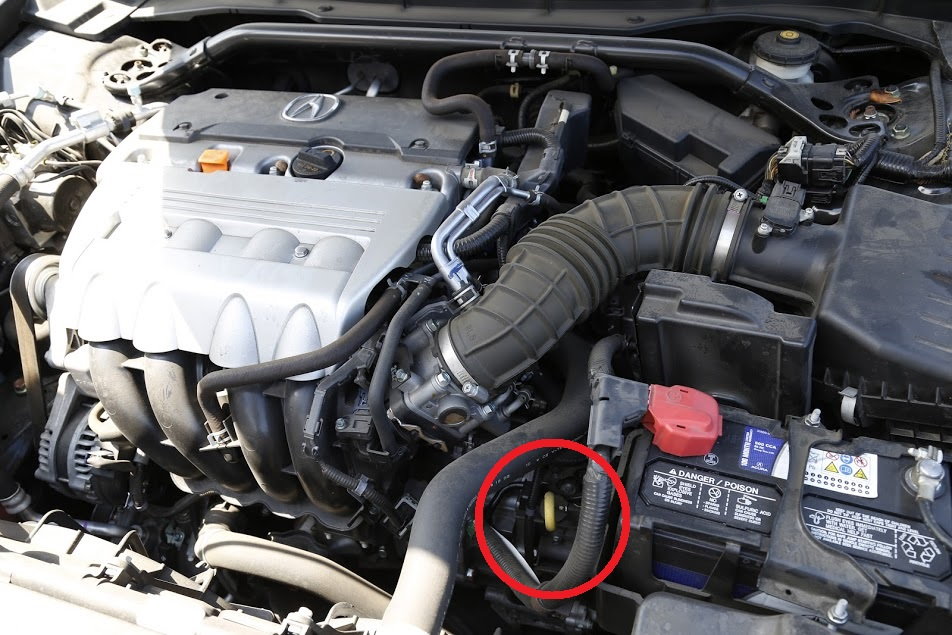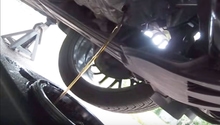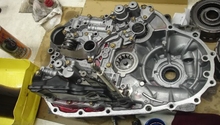Acura TSX 2004-2008: Transmission Diagnostic Guide
Your transmission drives the car, so keep it running smooth. Sounds important, but your transmission won't check itself!
This article applies to the Acura TSX (2004-2008).
The job of your Acura's transmission is simple on paper: it transmits the power of the engine to the driving wheels to make the car accelerate. However, if we expand upon that, it gets a bit more complicated: as engine spins (RPM), it's spinning the flywheel, which couples with either the clutch in a manual transmission, or the torque converter in an automatic transmission. From there, that force spins cogs in the transmission, which then spin the differential, which distributes power between the front axles, turning the wheels. Sounds a bit more complicated now, right? Fortunately, for the majority of its life, your Acura's transmission works smoothly and without issue. However, problems can arise, and after reading that, you can imagine that they could be problematic, to say the least. If your Acura's gearbox is acting up, worry not, we've got you covered with some common issues and fixes.

Materials Needed
- Socket wrench set
- Oil pan/bucket
- Car jack
- Gloves
- Replacement fluid
- Flashlight
- New solenoid
Step 1 – Check your codes
The transmission light has come on.
This only applies to the automatic transmission, as the manual transmission is mechanical, and does not have the same reliance on electrical controllers like the auto.
That said, the most common electrical-related issues with the TSX's automatic transmission are related to shift solenoids. These solenoids basically tell the transmission to shift gear. When the solenoid fails, the transmission may seem to be "stuck" in 2nd or 3rd gear and not upshift, or be recalcitrant with downshifting to a lower gear. These solenoids can fail and they will cause diagnostic trouble codes to appear on your dash.
Use a OBD-II trouble code reader and retrieve any error codes stored in the car's computer. If you do not have a code reader, most auto parts stores have this tool. Common transmission fault codes are P0974 and P0986.

Below are a few problems that may be occurring and some possible solutions.
Step 2 – Fluid leak
Leaks can occur with age, and general wear and tear.
This one applies to both manual and auto cars. Leaks can occur from the transmission pan or high pressure lines in the auto, or from the drain plug or main seal between the engine and transmission on the manual. Here are a few extras to check:
- Auto transmissions have a pan, much like the engine, for holding transmission fluid. Because it's low-hanging, it is occasionally prone to damage. Look for cracks or damage on the pan. Additionally, fluid can weep or leak from the seal between the transmission and pan. This is a matter of dropping the pan, using NEW bolts and the proper pan gasket or Hondabond, depending on the application.
- Your automatic transmission uses hard line (metal line) to feed pressurized transmission fluid across the transmission and to aid things like those pesky shift solenoids. While hard line is generally quite durable, it's not invincible. Check for leaks at the fittings, or joints, between the hard lines.
- If your car has a manual transmission, inspect the brake/clutch fluid reservoir for leaks or a low level. Some times Honda/Acura master cylinders and slave cylinders can fail prematurely, causing a leak. This may also manifest in troubles changing gear once the fluid level gets low.
- Have you replaced the manual transmission fluid recently? Did you forget to replace the one-time-use crush washer that goes with the drain plug? This can cause a slow leak. Usually this leak is very slow/minor, just make sure the drain plug is snug and consider changing your fluid soon to give you an excuse to replace that washer.
Step 3 – Overheating
Have you been towing a trailer up a steep hill with your TSX?
Overheating generally only applies to automatic transmissions. There may be a few causes of an overheated transmission. The fluid levels may be too low for the transmission to properly operate, the fluid lines could be clogged, or the load on the car may be too much. Provided your fluid is in good order, this becomes increasingly common as your vehicle ages, especially if you drive a very hilly climate.
- Check the fluid level in the transmission with the dipstick.
- Check the lines in the transmission for a clog. If the line is clogged, it may feel hot on one side of the clog, and cool on the other, signifying that the fluid is not getting through.
- If you are using the car to tow something, or if the weather is extremely hot, it may be the cause of overheating. Consider adding an auxiliary transmission cooler if you plan on doing this regularly.

Step 4 – Stuck in park
Again, this is an auto problem. If your Acura is stuck in park, and will not shift into neutral, reverse or drive, there are a few things to check.
Is your "check engine light" or VSA light on? You may have an electrical issue. Here are a few trouble codes related to the issue:
- P1760 Shift Lock Malfunction
- P1761 Shift Lock Short to Ground
- P1762 Shift Lock Short to B+
- P1763 Shift Lock Open
Have you tried cycling the car on and off several times?
- Try moving the shifter with the car off.
- If that doesn't work, try moving it as you're turning the car on.
Try toggling the shift lock pin:
- Look just below your shifter on the plastic trim panel that surrounds the shifter.
- Look for the small tab or indent. Flip that up and toggle the button underneath. That is the shift lock-out/reset toggle. See if the issue is resolved.

Step 5 – Slipping or grinding gears
You know what really grinds my gears?
Slipping refers to the engine RPMs shooting up, and the car not accelerating. This happens in a few instances:
- A damaged torque converter in your automatic transmission.
- If it's not the torque converter, your transmission may have an internal defect or damage.
- A worn clutch on a manual transmission causes the clutch to occasionally "slip" and not fully contact the flywheel, resulting in the power not making it to the transmission.
In all of these instances, these components require replacement.
Gear grinding is generally a delight reserved for manual transmissions, that said, it's not totally exclusive.
- Again, a worn clutch can cause gear engagement, or grinding issues.
- A leaking master cylinder, or clutch slave cylinder can cause insufficient pressure to transfer from you pushing down the clutch pedal to the transmission.
- A transmission low on fluid can cause gear grinding due to insufficient lubrication.
- Check your clutch pedal. Honda/Acura has released a procedure for adjusting the action, or movement, of the pedal. If the pedal is out of adjustment, it may not transmit enough hydraulic force through the master cylinder.
- Note that earlier model year TSXs have issues with 2nd and 3rd gear grinding/engagement and there are Technical Service Bulletins (TSBs) for this issue. Similarly, there were issues with gear "pop outs," where the transmission would pop out of gear during hard acceleration.
Related Discussions
- Check Transmission Light Came On - AcuraZine.com
- 2004 TSX Transmission Problem - AcuraZine.com
- Clutch Pedal Sticks to Floor, Does Not Go in Gear - AcuraZine.com
- Car Not Shifting Out of Park - AcuraZine.com






